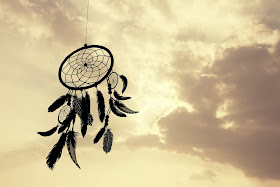Visit any tourist shop in the Southwest and you'll find the same items - turquoise rings, bracelets, earrings, and bolo ties; Kachinas in varying sizes; colorful, hand-loomed rugs; and dream catchers. It was this last item that sparked my interest. Aside from their beauty, the meaning behind them captivated me.
 |
| ©Deposit photos |
According to belief, Asibikaashi ('Spider Woman'), as she was known by the Ojibwa Chippewa tribe, was a spiritual protector of both adults and young children and babies. As the tribe spread across the nation, Asibikaashi instructed grandmothers and mothers to weave webs made of willow and sinew to protect their loved ones from harm. Feathers, beads, and other embellishments were added to further enhance the web's apotropaic magic.
 |
| ©Deposit photos |
The most accepted meaning of the dreamcatcher's shape is that the round circle represents the earth and moon, although newworldencyclopedia.org makes reference to the hoop representing the sun. The web's eight connections to the circle symbolize a spider's legs, and the feathers are thought to allow good dreams to float gently to the sleeping individual while any bad dreams get caught in the web, evaporating like dew when the morning sun hits them.
 |
| ©Deposit photos |
While many believe that the dreamcatchers of today are a violation of the culture, beliefs, and traditions of Native Americans, I must admit - I still find them charming.

I love Dream Catchers and have 4 in my bedroom and 2 in the laundry room. They add class to that space.
ReplyDeleteThank you so very much for this very interesting and informative post. We have had a dream catcher for a long time, and it is very pretty, it was given to us as a gift. I have read things on dream catchers and all is good about them. I didn't know about the legs of the spider were represented by the connections, that is really interesting and it makes sense. Thank you so much for sharing your information. Have a Great weekend. God Bless you.
ReplyDeleteJulie, at least you know your laundry won't have bad dreams 😉 I agree with you, though; they pretty up a room nicely!
ReplyDeleteThanks for your comment, Alicia. I love learning about the origins of different customs and why they're important. So much is commercialized these days - it's nice to go back to the beginning. You have a wonderful weekend, as well ❤